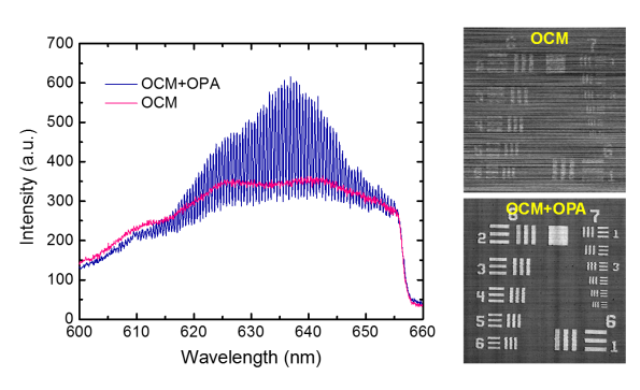Aug 12 2015
Optical coherence tomography (OCT) has emerged as an important in vivo imaging tool in modern biology an4d medicine. It enables large imaging depth as weak scattered light signals coming from structures deep inside light scattering tissues can be efficiently detected. Another advantage is its strong coherence gate (an effective time gate) resulting in high axial resolution and optical sectioning capability, and in addition, helping to reject multiply scattered background light.

Optical coherence microscopy (OCM) is a high-resolution variant of OCT that normally uses objectives of large numerical aperture (NA) to achieve high lateral resolution. Yet, as in all gating approaches, a compromise between signal strength and background rejection is inevitable – the reason for the known trade-off between imaging depth and spatial resolution in optical imaging of bulk scattering tissues.
A team from the University of Illinois at Urbana-Champaign (USA) now developed an optical parametric amplifier (OPA) to improve the performance of OCM imaging in scattering media. OPA is a nonlinear optical process in which energy is transferred among interacting light waves. The researchers implemented an OPA in their experiments which is based on a second order optical nonlinear process in an optical crystal. During the parametric interaction, an input pump photon on the crystal is divided into two daughter photons, called the signal and idler, with the sum of their energy equal to that of the pump. Any photons incident on the crystal with the same wavelength as the OPA signal will be amplified under phase-matching, along with the generation of an idler beam.
By incorporating the specially designed OPA, Stephen A. Boppart and his co-workers achieved an enhancement in imaging performance of a spectral-domain OCM in turbid media: sensitivity, imaging depth, and spatial resolution in imaging microstructures in highly scattering media were simultaneously improved.
The OPA provides a high level of optical gain to the sample arm, with minimal extra noise, which helps suppress multiple types of noise contributions. The signal-to-noise ratio of the OCM could be improved by a factor of up to 15 dB. A unique nonlinear confocal gate is automatically formed in the OPA, which enables selective amplification of singly scattered (ballistic) photons against the multiply-scattered light background.
The study further confirms the coherent nature of the OPA process, suggesting that OPA detection can preserve the optical information carried by the signal photons. This makes the OPA potentially useful as a general purpose optical amplifier in other optical biomedical imaging modalities where the detection of weak signals is a pervasive challenge. In particular, this technology should be easily implemented in fibre-based OCT systems.
(Text contributed by K. Maedefessel-Herrmann)
See the original publication: Youbo Zhao, Haohua Tu, Yuan Liu, Andrew J. Bower, Stephen A. Boppart, Enhancement of optical coherence microscopy in turbid media by an optical parametric amplifier, J. Biophotonics 8:6, 512-521 (2015); doi: http://dx.doi.org/10.1002/jbio.201400073